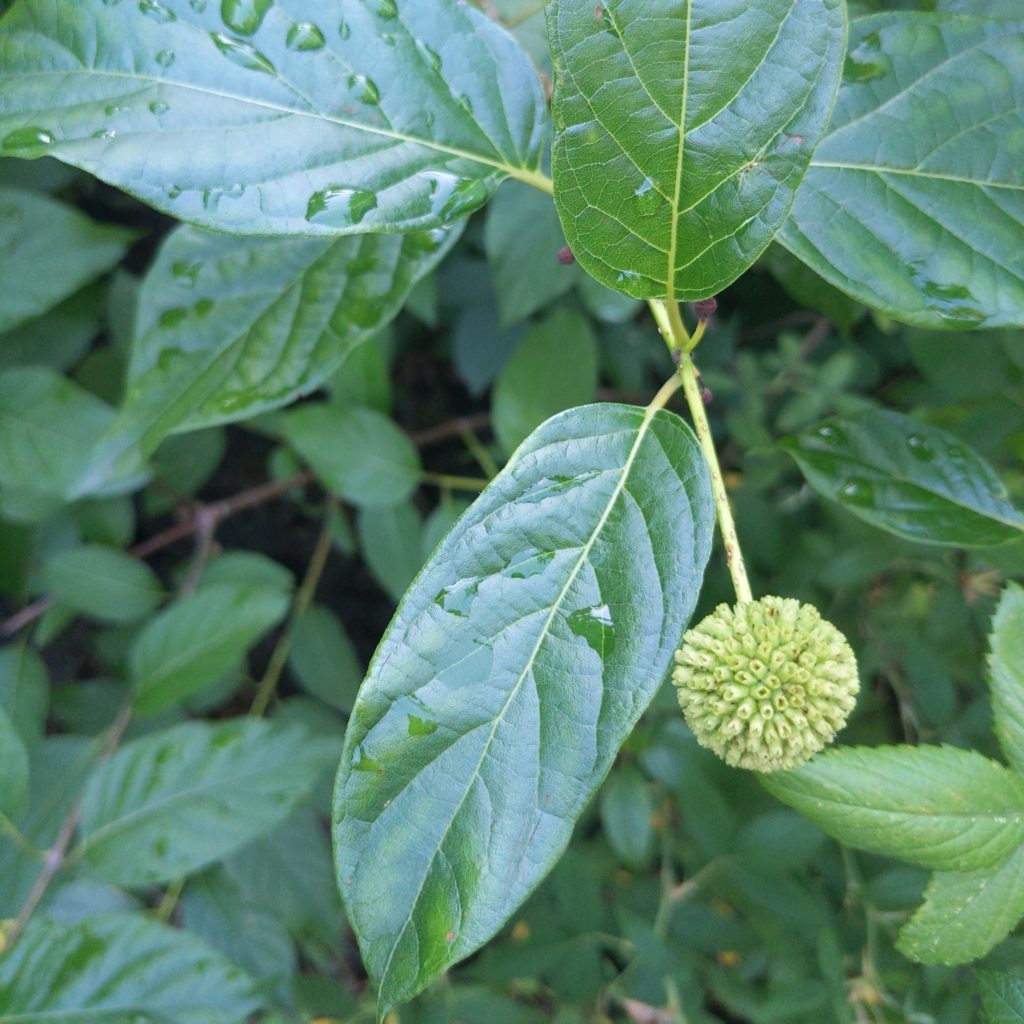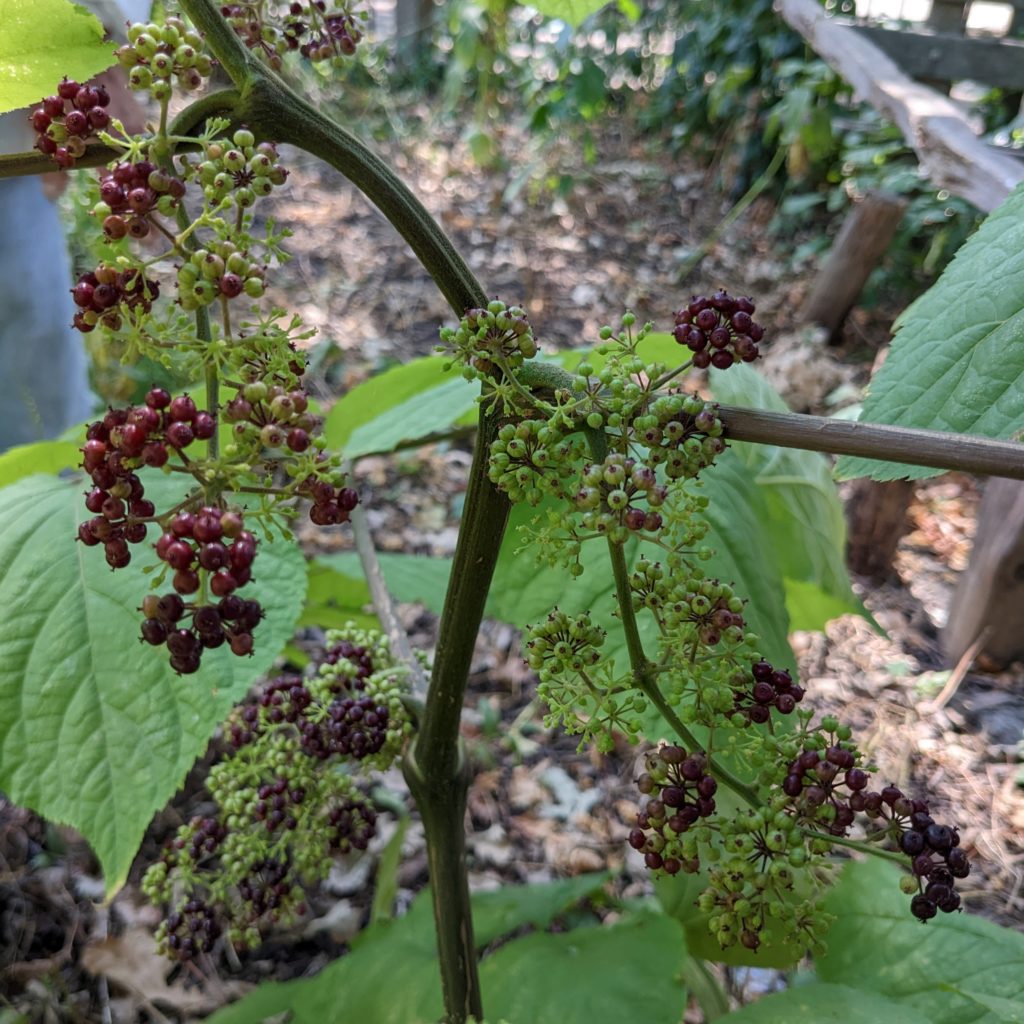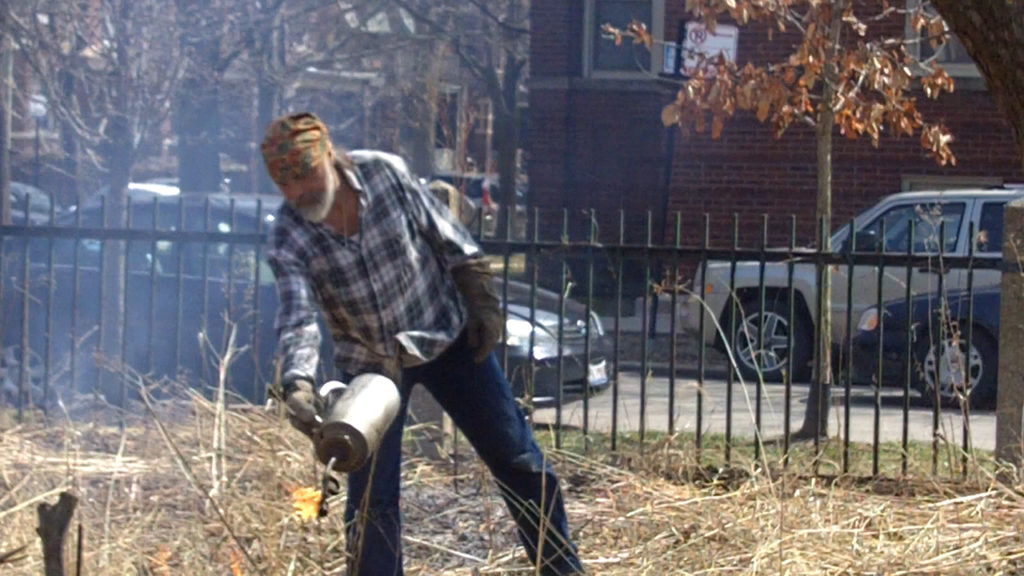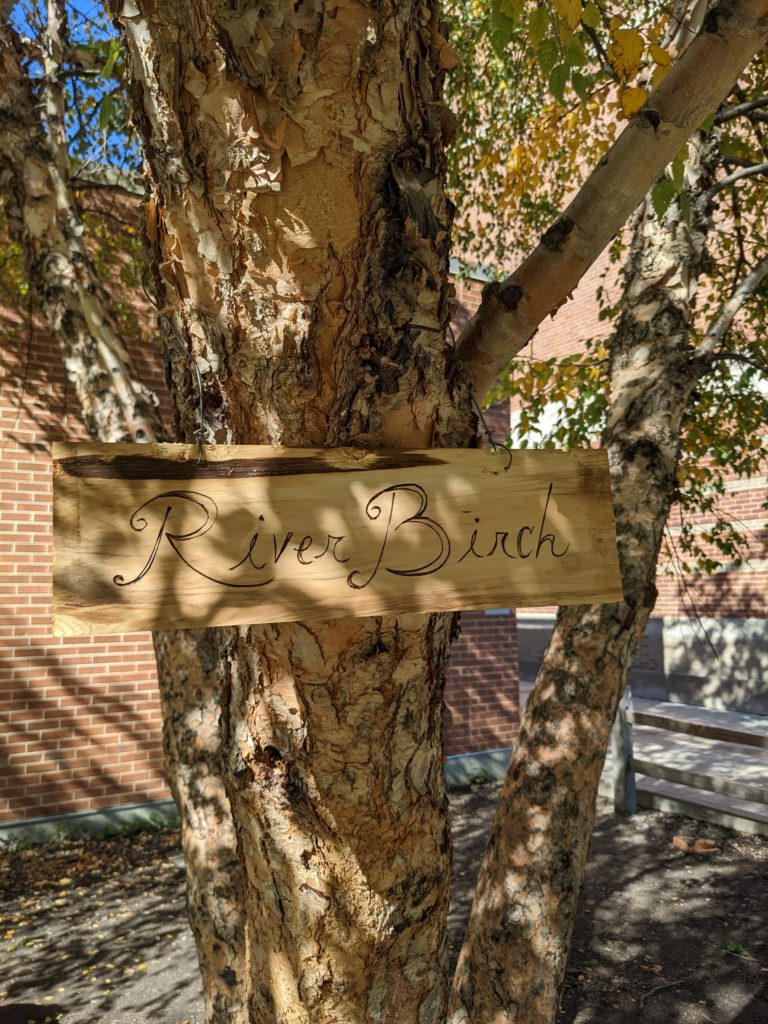A history of the Waters School & Community Gardens written by Pete Leki, former director of ecology programs, in July 2009 and updated in October 2018.
In the beginning
In the Fall of 1991, Waters’ school grounds were barren: almost solid asphalt for an entire city block. There were a few shade trees encased in asphalt. We had no soil. There was some gravel, some broken playground equipment: swings with no swings, teeters without totters.

But, at the south end of the lot we did have four colossal grandfather bur oak trees. Oaks that predate the school, the civil war, perhaps, the city’s founding. Oaks that once sheltered Potowatomi camps. These are the signature trees of our region: the oaks of the Midwest oak savannas: long-lived, burly, thick barked, resistant to the fire that formed created the prairies and savannas. And we soon found out that they once stood on the banks of the Chicago River, when it was slowly meandering prairie river, taking its old time moving to the Lake.
Native plants
Our first gardens were two small rings planted around two of the oaks. We modeled our first gardens on the plant communities we saw at Sauganash Prairie Grove, remnant communities of rare and intriguing plants. Every year we added to the gardens: buying soils or creating our own in compost bins; buying or raising our own native plants from seeds we gathered. Eventually, native plant ensembles representing woodlands, wetlands, savannahs, and prairies were created.
Our oaks stood, stranded, for nearly one hundred years without progeny: no place to sprout, no hope for habitat. But, starting that first year, young heritage oaks sprouted, squirrel-planted. And each year since, cohorts of bur oaks have sprouted and grown.
Around and amid them, we sought out and planted native species: sometimes wisely, sometimes not. Today our gardens include more than 150 native species, including some rare and endangered ones. Some clear mistakes may be apparent to persons with some experience in trying to mimic nature: the too-soon inclusion of certain species in the plant mix: sunflowers, cup plant, rosin weed, New England Aster, Joe Pye Weed. These are all wonderful natives, but planted in fallow ground, without competition, they become monstrous versions of their restrained, wild selves. In my experience, grasses and sedges should be the priority plants, intermixed with conservative natives like blazing stars, shooting stars, royal catchfly, baptisias, butterfly weed, native thistles in the prairies, and baneberry, wild iris, wood and Turk’s Cap lily, starry campeon, thimbleweed, swamp saxifrage, etc, in the woodlands and wetlands. The almost impossible task of re-creating the Spring ephemeral community, on top of (or rather underneath) the rest of the seasonal communities, makes a humbled gardener appreciate anew the great mastery of nature in creating biodiversity with beauty and efficiency.






Prescribed burns
Starting in 1999, we began the permitted, prescribed burning of our native gardens in the Spring, to give advantage to fire-evolved species. This neighborhood spectacle, though is a serious and focused activity, has becoming a non-controversial, celebratory tradition in the community. Scores of neighbors have become trained participants.



Vegetable gardens

Soon enough our teachers began to ask if we could find space for “normal” gardens. Though they loved and used the natives, they wanted the opportunity to grow annual flowers and vegetables. The gardens grew and more compost was created and the school’s field house became an arts and ecology workshop during the day, and a community center with English and Spanish classes, meetings of parents, women’s groups, boy scouts, special presentations on bats, and flooding, education and the river.
We started doing Spring and Autumn Garden Clean-Ups and Festivals where scores, and hundreds of kids with parents, and friends and neighbors would come by to work play and eat. We received a truckload of logs from the Forestry Departments and, Egyptian style, moved them into circle around a fire ring. Hundreds of plates were served pot luck: rich and spicy Mexican, Central and South American dishes, next to foods from all corners of the world. Huge amounts of work were accomplished chipping paths, building fences, weeding and planting.

As new gardens were planted, and fences were built, we decided to never miss the opportunity to plant edible perennials along them: grapes, raspberries, currants and gooseberries. These plants not only armored our fencing with their prickles, but invited our students and the entire community to a free feast of ripe summer berries.
Neighbors and community garden
More and more often, neighbors would stop by asking if it was a community garden and could they be a part of it. We decided then to open up an entirely new area for that use. Early in that year one of our school families tragically lost their second grader to an unexpected death. We named the garden the Jose Alanis Community Gardens in his honor.
For a number of years we had received funding for summer school programming, and used this to maintain our gardens and teach some botany. When the funds ran out we worked out an arrangement with our community gardeners, that in exchange for a small plot of land, they would help maintain the rest of the gardens. Soon we ran out of garden plots, but neighbors and parents continued to come to the regular weekly work nights to pitch in, to socialize, to eat and sing and make new friendships. It soon became clear that the garden had created an atmosphere of relaxed accomplishment, of learning and laughing, of crossing boundaries of language and culture. There was almost no cost involved. I organized the list of tasks, everyone pitched in. We were always a little behind in our maintenance but the garden was receiving awards and accolades.
Not everybody was in love with the garden. One lady used to come in every Spring for several years. She came in like a little army sergeant, with hair piled up in a big tube on her head, arms waving, “What is this? What is this?” For the first couple years this always took me by surprise, as though she was asking, literally, “What place am I in?” and I would answer, “Well, this is a garden. It is part of the school.” But, she wouldn’t relent. “But. What is this!” she demanded again. “This is terrible.” “What is terrible?”, I asked, baffled, with bemused gardeners looking on. “This!” she waved and pointed. “This! This! This is terrible! This used to be a playground…”

There was no convincing this lady and after a few years I stopped trying. But, I think she represented a segment of the community that found the profusion of native plants… scary. And that were convinced that the plants were “just weeds”. They are not. I would challenge anyone to look carefully at out plantings and compare them to the weeds that sprout in vacant lots. To the contrary, our plant communities are rare, conservative, and exceptional. But, in the push and pull of urgent tasks to be finished, we would post information every now and then, and explanation of the gardens: its history and ecology and organizational lay out. But, these papers soon dissolved in the rain and wind. Educational, informational signage has been an on-going weak point of ours.
Refuge Garden and mosaics
It seemed that each year we would start a new planting project integrated in some way with science and ecology, or writing and the fine arts. Much of this was done by our middle school, beginning with the Refuge Garden, by the school entrance, a year long multi-class project to explore the idea of finding refuge in a beautiful, live, peaceful place after fleeing the horrors of war and/ or poverty in Bosnia, Mexico and Central America.

The Refuge garden was our first foray away from the main garden on the southern end of the lot. It featured a collaboration with two artists, Cynthia Weiss (mosaics) and Phil Schuster (sculptor). Journeys and Refuge went deep into our school family’s stories of the journeys and trials that brought them to Chicago. The stories were developed in writing workshop in the school and at parent workshops. They were later distilled into graphic icons that appear in mosaic form on the bench created by Cynthia and Phil. The many, enigmatic images that appear in the bench represent the actual journeys and experiences of our school families.
Rainwater retention
Next came the Watershed garden, funded through the Friends of the Chicago River to retain rainwater on site. This monumental project took 18 months to complete. The garden is 4,000 square feet in size, situated around the perimeter of the playground.
The entire asphalt surface was removed by hand: by students, parents, and neighbors, using crowbars, sledge hammers and wheel barrows. I remember well the first blow, the euphoric happiness we felt, all gathered round, to release the earth from the asphalt sarcophagus. This was monumental, difficult work that bound school community together in a great and inspiring effort. Below the asphalt was a two-foot deep layer of boiler cinder that also had to be removed.
In the end, the entire new garden was planted in native edibles: hazelnut, plum, walnut, black cherry, pawpaw, raspberry, grape, currant gooseberry, mints, grains, edible sunflowers, roses, strawberries, and flowers. It sequestered, by student calculation 120,000 gallons of water per year, diverting this precious rain water from the sewers and, instead, into plants and food.
Outdoor classroom
Next, the class of 2004 designed and built a “Classroom in a Garden”, transforming barren asphalt into a flower enclosed oasis with 8 spool tables and 32 tree stump seats, enough to host a classroom, or our school staff for lessons or celebrations. During this year, two of our students passed away, and in their memory, heritage oak tree saplings were planted.
Student advocacy and school renovation
The next year, our eighth grade class voted to take up a campaign to ask the Board of Education to remove the remaining asphalt from the school grounds:
- To create a safer playing area for the students
- To make a more beautiful school grounds for our community, and
- To divert more rain water from the sewer system and in this way sparing the Chicago River the episodic dosing with raw sewage.
To this end our students wrote letters, signed petitions and made a beautiful documentary film called “The Gift.” The Board of Education responded positively, promised prompt action, and the after the school year, reneged. Nevertheless, two years later the much-elaborated project was begun.
In 2008 a major capital improvement project began at Waters. Despite the resistance and heartbreak expressed by the school community, the Board of Education and the Alderman’s office determined that the Field house would be demolished, and, theoretically, is functions would be taken over by a silver-LEED school addition. Two and one-half acres of asphalt would be removed, and all rainwater on site would be channeled into bio-swales, to follow its natural course into the ground.
Today in the garden
The school gardens are linked to the school’s educational mission: gardens that represent historical communities and that create habitat for native insects, birds and other animals, and/or gardens that produce food and make the implicit connection for children between the earth and our sustenance.
Our school community, and the vast majority of our neighborhood, stand in awe of the gardens created by our school and Mother Earth: here they find, freely given: berries, peace, beauty, quiet, friendship, joy. This is only the beginning of a network of restored lands that will reclaim health and biodiversity to our land.

Special thanks to Jeremy Atherton for many of the photos that appear on this page.